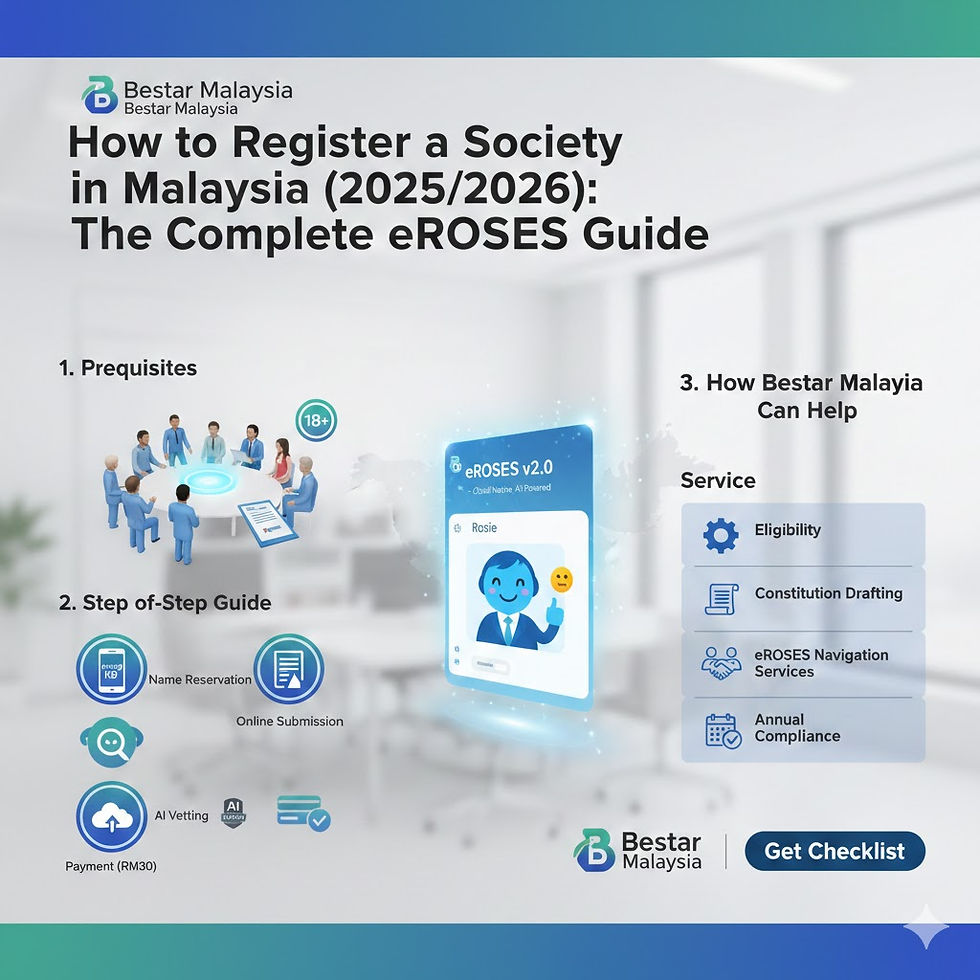Dissolution of Limited Liability Partnership in Malaysia
- Roger Pay
- Jun 10, 2025
- 6 min read
LLP Dissolution in Malaysia Explained
In Malaysia, the dissolution of a Limited Liability Partnership (LLP) is governed by the Limited Liability Partnerships Act 2012 (LLP Act 2012). There are generally three main ways an LLP can be dissolved:
Voluntary Winding-Up by Partners (Most Common Method): This is the preferred method when the partners decide to cease operations and the LLP is solvent (able to pay its debts). The process involves several key steps:
Cessation of operations and discharge of debts: The LLP must have ceased its business activities and fully settled all its debts and liabilities.
Notice to Partners: A notice of the intention to dissolve the LLP must be sent to all partners via registered post to their last known address.
Tax Clearance from LHDN (IRB): The LLP must obtain a written notice from the Inland Revenue Board of Malaysia (LHDN/IRB) stating that they have no objection to the dissolution. This usually requires submitting the final tax return and obtaining clearance.
Newspaper Publication: A notice of the proposed dissolution must be published in at least one widely circulated Malaysian newspaper in both the national language (Bahasa Melayu) and English.
Application to Registrar (SSM): An application for a declaration of dissolution, along with a Statutory Declaration by a partner, copies of the notices sent to partners, the IRB clearance, and newspaper publications, must be submitted to the Companies Commission of Malaysia (SSM) via the MyLLP system. This application must be made within 7 days from the date of the notice to partners or the newspaper publication, whichever is later. An extension of time can be applied for, but it usually doesn't exceed 30 days.
Objection Period: Any partner or creditor has a 30-day period from the date of the notice or publication to raise objections to the dissolution. If an objection is received, the Registrar will notify the applicant, and the objection must be resolved.
Registrar's Decision and Asset Distribution: If no valid objections are raised or objections are resolved, the Registrar will declare the LLP dissolved. The LLP can then proceed with the transparent and fair distribution of any surplus assets among the partners, adhering to the LLP agreement.
Notification of Completion of Distribution: The applicant must notify SSM of the completion of asset distribution within 14 days. This notification is required even if there are no assets.
Compulsory Winding-Up by Court: This typically occurs when an LLP is insolvent (unable to pay its debts) or for other reasons deemed just and equitable by the court. A petition is filed in court by parties such as creditors, partners, or the Registrar. If the court orders a winding-up, a liquidator (or the Official Receiver) is appointed to manage the liquidation of assets, settle debts, and distribute any remaining funds. The relevant provisions of the Companies Act 2016 regarding winding-up by court are generally applicable to LLPs.
Striking-Off by Registrar (SSM): The Registrar has the power to strike off an LLP from the register under certain circumstances, such as when the LLP is no longer carrying on business, has contravened the LLP Act 2012, or is prejudicial to national interests. While there's no specific guideline for applying for a striking-off by the LLP itself, the Registrar may initiate this process.
Important Considerations:
Compliance Officer: The Compliance Officer of the LLP plays a crucial role in overseeing the dissolution process.
Professional Advice: Dissolving an LLP can be complex, and it is highly recommended to seek professional legal and accounting advice to ensure compliance with all legal requirements and to facilitate a smooth process.
Liability: Even after striking off, the liability of every partner may continue and can be enforced as if the LLP had not been struck off, especially if there are outstanding debts.
The dissolution process aims to ensure that all affairs of the LLP are properly wound up, debts are settled, and any remaining assets are distributed in a legally compliant manner before the LLP ceases to exist as a legal entity.
How Bestar can Help
Dissolution of Limited Liability Partnership in Malaysia
Professional accounting advice is indispensable during the dissolution of a Limited Liability Partnership (LLP) in Malaysia (or any jurisdiction, for that matter) for several crucial reasons. Here's how Bestar can help:
Ensuring Legal Compliance:
Adherence to LLP Act 2012: Bestar ensures that every step of the dissolution process strictly complies with the Limited Liability Partnerships Act 2012 and its subsidiary legislations. This prevents future legal challenges or penalties.
SSM Requirements: We are well-versed with the specific requirements and procedures of the Companies Commission of Malaysia (SSM) for LLP dissolution, including proper documentation and submission deadlines.
Understanding Statutory Declarations: Bestar guides partners on the implications of statutory declarations required by SSM, ensuring they are accurate and legally sound.
Drafting and Reviewing Documentation:
Notices and Resolutions: Bestar drafts all necessary notices to partners, creditors, and the public, ensuring they are legally sufficient and accurately reflect the LLP's intentions.
Applications to SSM: We prepare and review the application for declaration of dissolution, ensuring all required documents are attached and correctly formatted.
Indemnity Agreements: If there are complex distributions or potential future liabilities, lawyers can draft indemnity agreements to protect partners.
Managing Creditor and Partner Disputes:
Handling Objections: If creditors or partners raise objections during the 30-day objection period, Bestar can strategically manage these objections, negotiate settlements, or advise on appropriate professional responses.
Minimizing Personal Liability: We advise partners on steps to minimize their personal liability, especially in cases where the LLP's solvency might be questionable.
Tax Implications and Clearance:
Tax Advisory: While handling tax, Bestar understands the legal implications of tax non-compliance during dissolution and can collaborate with tax advisors to ensure comprehensive tax clearance from LHDN.
Risk Mitigation:
Undisclosed Liabilities: Bestar can advise on how to manage the risk of previously undisclosed liabilities emerging after dissolution.
Guidance on Asset Distribution:
LLP Agreement Interpretation: We interpret the LLP agreement to ensure that asset distribution among partners is done in accordance with the agreed terms, preventing internal disputes.
Prioritizing Payments: We advise on the legal order of priority for settling debts (e.g., secured creditors vs. unsecured creditors) before distributing to partners.
Financial Health Assessment:
Solvency Check: Bestar performs a thorough financial analysis to confirm the LLP's solvency (ability to pay all its debts) before initiating voluntary dissolution. This is critical as an insolvent LLP requires a different, more complex winding-up process.
Asset and Liability Valuation: We accurately value all assets and liabilities of the LLP, ensuring a clear financial picture.
Tax Clearance and Compliance:
Final Tax Return: This is paramount. Bestar prepares and submits the final tax return for the LLP to the Inland Revenue Board of Malaysia (LHDN/IRB).
Obtaining LHDN Clearance: We manage the process of obtaining the crucial written notice from LHDN stating no objection to the dissolution, which involves settling all outstanding taxes, penalties, and ensuring all tax filings are up-to-date.
Withholding Tax: Advising on any withholding tax implications if payments are made to non-residents.
SST De-registration: If applicable, we handle the de-registration process with the Royal Malaysian Customs Department for Sales and Service Tax (SST).
Financial Reporting and Audit:
Preparation of Final Accounts: We prepare the final set of financial statements (balance sheet, profit and loss account) up to the date of dissolution.
Audit Requirements: Advise if a final audit is required and coordinate with auditors.
Debt Management and Settlement:
Creditor Identification: Identifying all creditors and quantifying the amounts owed.
Payment Scheduling: Assisting in the orderly payment of all creditors and liabilities.
Bank Account Closure: Guiding on the process of closing bank accounts once all financial obligations are met.
Asset Realization and Distribution:
Maximizing Asset Value: Advising on strategies to realize the best possible value from the LLP's assets during liquidation.
Accurate Distribution Schedule: Preparing a clear and accurate schedule for the distribution of remaining assets to partners, ensuring compliance with the LLP agreement and tax regulations.
Capital Account Closure: Properly closing out partner capital accounts.
Payroll and Employee Matters:
Final Salary Payments: Ensuring all final salaries, bonuses, and severance payments to employees are correctly calculated and disbursed.
EPF/SOCSO/EIS Contributions: Handling final contributions to the Employees Provident Fund (EPF), Social Security Organization (SOCSO), and Employment Insurance System (EIS).
Tax Clearance for Employees: Assisting employees with their individual tax clearance if necessary (e.g., form CP21).
In essence, Bestar ensures the dissolution is legally sound, compliant, and protects the partners from future liabilities, while ensuring it is financially accurate, transparent, and tax-efficient. Engaging Bestar provides a holistic approach, minimizing risks and ensuring a smooth and effective winding-up of the LLP.




Comments